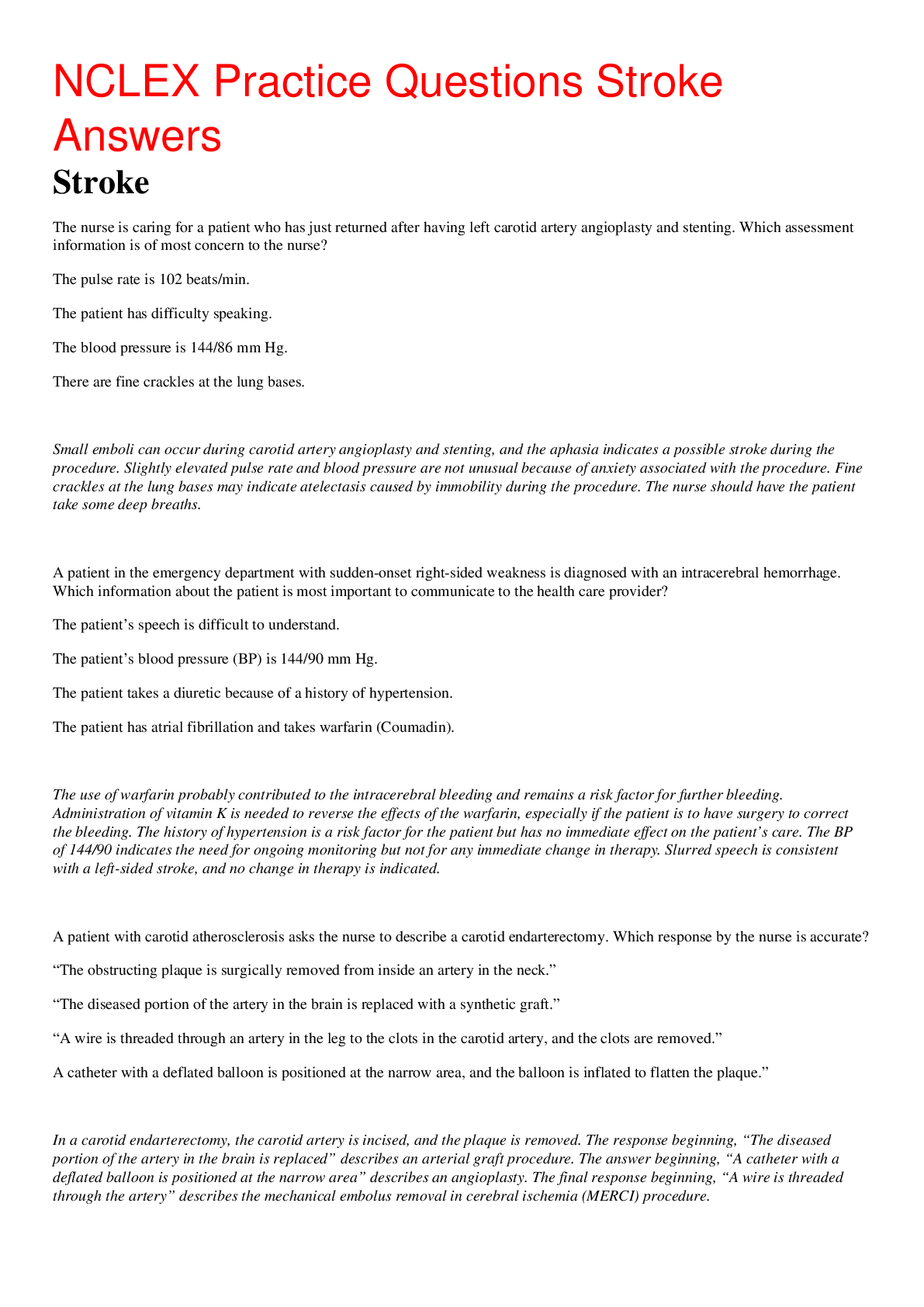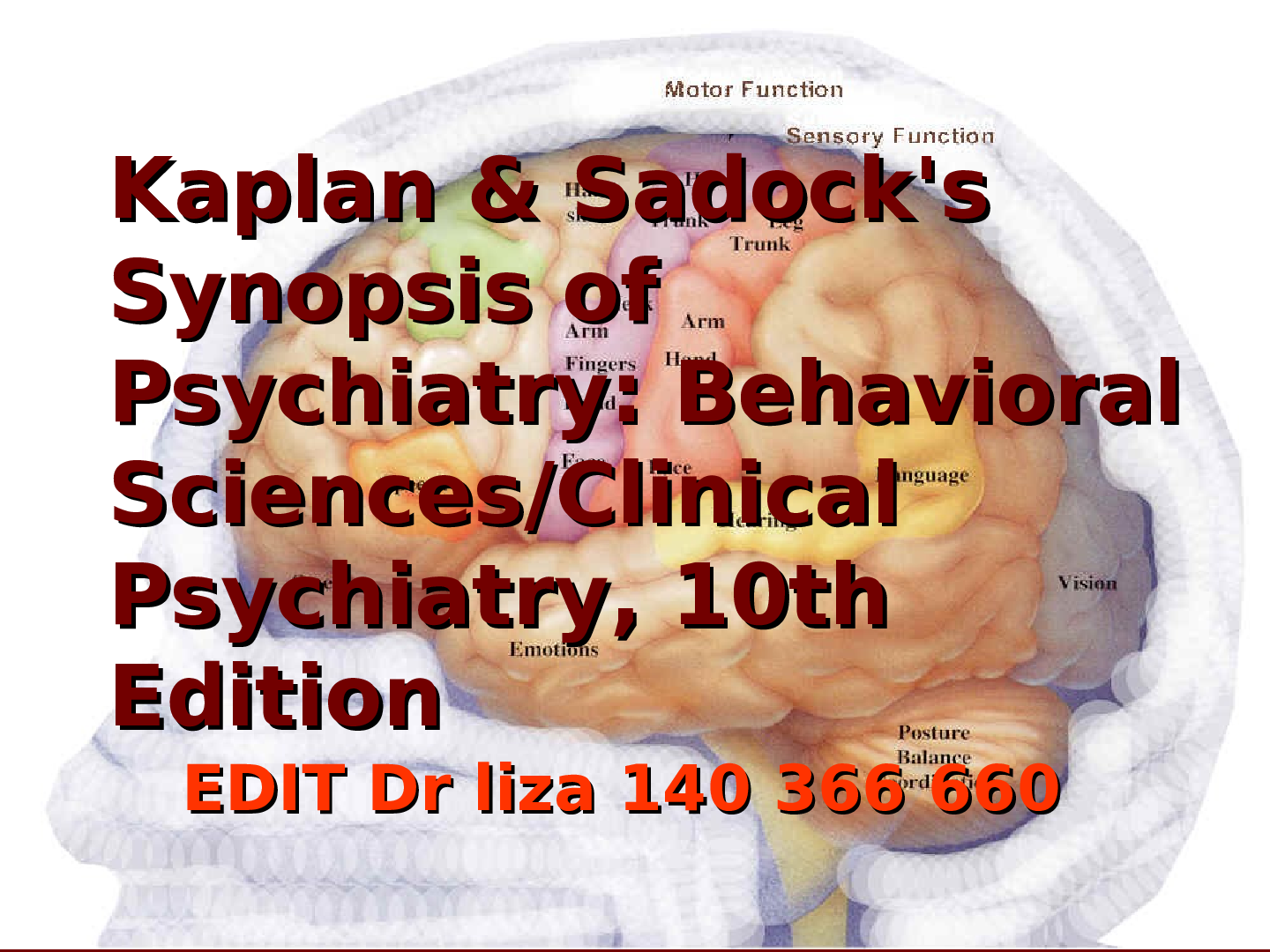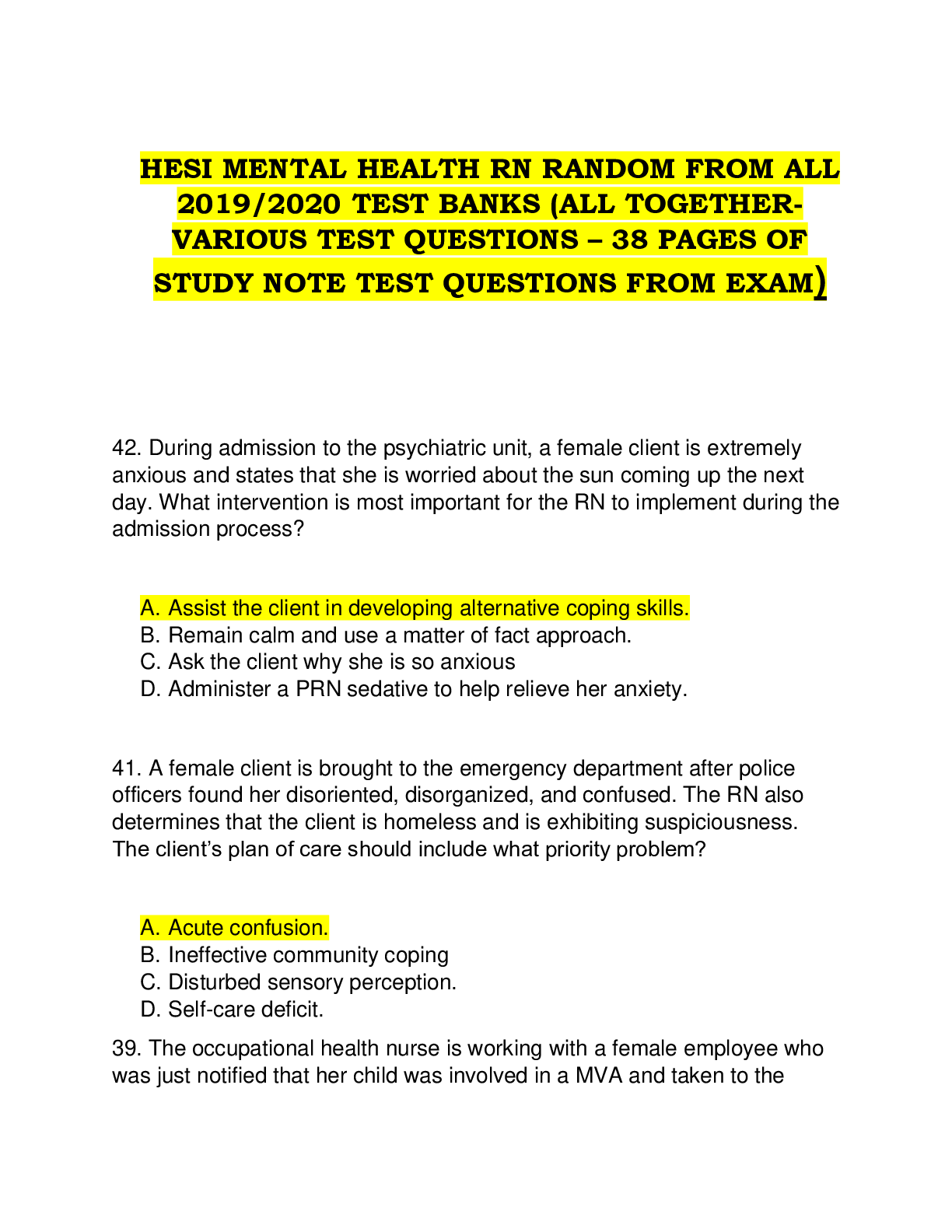*NURSING > STUDY GUIDE > NCLEX Practice Questions Stroke With All Complete UPDATED Answers (All)
NCLEX Practice Questions Stroke With All Complete UPDATED Answers
Document Content and Description Below
NCLEX Practice Questions Stroke With All Complete NCLEX Practice Questions Stroke Answers Stroke 1. The nurse is caring for a patient who has just returned after having left carotid artery angiop... lasty and stenting. Which assessment information is of most concern to the nurse? a. The pulse rate is 102 beats/min. b. The patient has difficulty speaking. c. The blood pressure is 144/86 mm Hg. d. There are fine crackles at the lung bases. Small emboli can occur during carotid artery angioplasty and stenting, and the aphasia indicates a possible stroke during the procedure. Slightly elevated pulse rate and blood pressure are not unusual because of anxiety associated with the procedure. Fine crackles at the lung bases may indicate atelectasis caused by immobility during the procedure. The nurse should have the patient take some deep breaths. 2. A patient in the emergency department with sudden-onset right-sided weakness is diagnosed with an intracerebral hemorrhage. Which information about the patient is most important to communicate to the health care provider? a. The patient’s speech is difficult to understand. b. The patient’s blood pressure (BP) is 144/90 mm Hg. c. The patient takes a diuretic because of a history of hypertension. d. The patient has atrial fibrillation and takes warfarin (Coumadin). The use of warfarin probably contributed to the intracerebral bleeding and remains a risk factor for further bleeding. Administration of vitamin K is needed to reverse the effects of the warfarin, especially if the patient is to have surgery to correct the bleeding. The history of hypertension is a risk factor for the patient but has no immediate effect on the patient’s care. The BP of 144/90 indicates the need for ongoing monitoring but not for any immediate change in therapy. Slurred speech is consistent with a left-sided stroke, and no change in therapy is indicated. 3. A patient with carotid atherosclerosis asks the nurse to describe a carotid endarterectomy. Which response by the nurse is accurate? a. “The obstructing plaque is surgically removed from inside an artery in the neck.” b. “The diseased portion of the artery in the brain is replaced with a synthetic graft.” c. “A wire is threaded through an artery in the leg to the clots in the carotid artery, and the clots are removed.” d. A catheter with a deflated balloon is positioned at the narrow area, and the balloon is inflated to flatten the plaque.” In a carotid endarterectomy, the carotid artery is incised, and the plaque is removed. The response beginning, “The diseased portion of the artery in the brain is replaced” describes an arterial graft procedure. The answer beginning, “A catheter with a deflated balloon is positioned at the narrow area” describes an angioplasty. The final response beginning, “A wire is threaded through the artery” describes the mechanical embolus removal in cerebral ischemia (MERCI) procedure. 4. A patient who has a history of a transient ischemic attack (TIA) has an order for aspirin 160 mg daily. When the nurse is administering medications, the patient says, “I don’t need the aspirin today. I don’t have a fever.” Which action should the nurse take? a. Document that the aspirin was refused by the patient. b. Tell the patient that the aspirin is used to prevent a fever. c. Explain that the aspirin is ordered to decrease stroke risk. d. Call the health care provider to clarify the medication order. Aspirin is ordered to prevent stroke in patients who have experienced TIAs. Documentation of the patient’s refusal to take the medication is an inadequate response by the nurse. There is no need to clarify the order with the health care provider. The aspirin is not ordered to prevent aches and pains. 5. A patient with a left-brain stroke suddenly bursts into tears when family members visit. The nurse should: a. use a calm voice to ask the patient to stop the crying behavior. b. explain to the family that depression is normal following a stroke. c. have the family members leave the patient alone for a few minutes. d. teach the family that emotional outbursts are common after strokes. Patients who have left-sided brain stroke are prone to emotional outbursts that are not necessarily related to the emotional state of the patient. Depression after a stroke is common, but the suddenness of the patient’s outburst suggests that depression is not the major cause of the behavior. The family should stay with the patient. The crying is not within the patient’s control, and asking the patient to stop will lead to embarrassment. 6. A patient has a ruptured cerebral aneurysm and subarachnoid hemorrhage. Which intervention will the nurse include in the plan of care? a. Apply intermittent pneumatic compression stockings. b. Assist to dangle on edge of bed and assess for dizziness. c. Encourage patient to cough and deep breathe every 4 hours. d. Insert an oropharyngeal airway to prevent airway obstruction. The patient with a subarachnoid hemorrhage usually has minimal activity to prevent cerebral vasospasm or further bleeding and is at risk for venous thromboembolism. Activities such as coughing and sitting up that might increase intracranial pressure or decrease cerebral blood flow are avoided. Because there is no indication that the patient is unconscious, an oropharyngeal airway is inappropriate. 7. A 70-yr-old female patient with left-sided hemiparesis arrives by ambulance to the emergency department. Which action should the nurse take first? a. Take the patient’s blood pressure. b. Check the respiratory rate and effort. c. Assess the Glasgow Coma Scale score. d. Send the patient for a computed tomography (CT) scan. The initial nursing action should be to assess the airway and take any needed actions to ensure a patent airway. The other activities should take place quickly after the ABCs (airway, breathing, and circulation) are completed. 8. After receiving change-of-shift report on the following four patients, which patient should the nurse see first? a. A 60-yr-old patient with right-sided weakness who has an infusion of tPA prescribed b. A 50-yr-old patient who has atrial fibrillation and a new order for warfarin (Coumadin) c. A 30-yr-old patient with a subarachnoid hemorrhage 2 days ago who has nimodipine scheduled d. A 40-yr-old patient who experienced a transient ischemic attack yesterday who has a dose of aspirin due [Show More]
Last updated: 2 years ago
Preview 1 out of 3 pages

Buy this document to get the full access instantly
Instant Download Access after purchase
Buy NowInstant download
We Accept:

Reviews( 0 )
$4.00
Can't find what you want? Try our AI powered Search
Document information
Connected school, study & course
About the document
Uploaded On
Jun 17, 2020
Number of pages
3
Written in
Additional information
This document has been written for:
Uploaded
Jun 17, 2020
Downloads
0
Views
89



 Rasmussen College.png)










